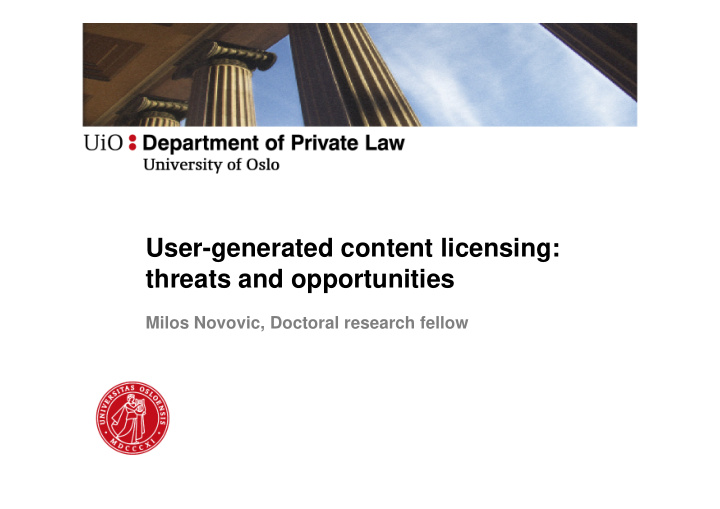



User-generated content licensing: threats and opportunities Milos Novovic, Doctoral research fellow
Introduction • About me • Presentation structure • What we already know about Terms of Service agreements? – Few people read them – They are non-negotiable – They often contain provisions that are unfavorable to the users Th i f bilit i ft ll d i t ti
My research project • Look at ToS agreements not from the contract law or customer protection law perspective, but from the intellectual property law perspective • Look for IP-related clauses in major ToS agreements and ask: – What do they typically regulate? – Are they potentially harmful to the users and can they be detrimental to the general goals of IP law? – If so, what steps can be taken to remedy this situation?
Methodology • Normative analysis of ToS – Get a sample – Identify industry standardization through side-by-side comparison of ToS – Identify emerging trends by looking at how ToS have changed over time (web archives) • Identify broader policy implications through inductive process and analyze them through the prism of IP theoretical framework • When trying to demonstrate harm or to provide l i l i l h k h ld
Initial analysis • Not too difficult to find ToS agreements with controversial IP clauses: – “Any and all copying from this website is prohibited” – “Reverse engineering/decompilation is not allowed” – Prohibit creation of derivative works – Prohibit renting, leasing, sublicensing – Restrict use to certain categories of population
A new pattern: UGC • However, in a vast majority of cases, agreements contain IP clauses related to licensing user content, rather than just to prevent users from copying website/software elements • These licensing clauses are often extremely broad, and assign companies e.g. “a non- exclusive, transferable, sub-licensable, royalty-free worldwide license to use any IP
Twitter ToS By submitting, posting or displaying Content on or through the Services, you grant us a worldwide, non-exclusive, royalty-free license (with the right to sublicense) to use, copy, reproduce, process, adapt, modify, publish, transmit, display and distribute such Content in any and all media or distribution methods (now known or later developed). You agree that this license includes the right for Twitter to provide, promote, and improve the Services and to make Content submitted to or through the Services available to other companies , organizations or individuals who partner with Twitter for the syndication, broadcast, distribution or publication of such Content on other media and services, subject to our terms and conditions for such Content use. Such additional uses by Twitter, or other companies, organizations or individuals who partner with Twitter, may be made with no ti id t ith t t th C t t th t b it
Why is this being done? • A standard explanation being offered is that these clauses simply exist as to allow companies to legally display/store/transmit content, without worrying about getting sued • If so, why not use a more narrow clause instead of the sweeping one? • User content is ultimately valuable to companies because of the personal data that can be retrieved from it, not because of its creative value • Economic gain is nowadays often found in
Data duality • An IP law clause is used to license content, but the actual goal is to acquire personal data associated with that content • IP law has to recognize the “duality” of data contained in UGC: creative + personal • Deficiencies in IP laws used to justify privacy reductions?
Legal uncertainty • Legal uncertainty regarding the establishment of the license, parties involved, its scope and the termination conditions • For example: – what happens when content is uploaded by someone who is not its author – or otherwise has no right to give a license? – given that the user content often contains third parties’ personal information, what level of their consent, if any, is necessary for the license to be upheld? – in which cases should further license transfers or sublicensing agreements by the licensee require additional explicit user
Example: license to create derivative works • FB sponsored stories
Privacy/data protection laws • Have an important role to play, but cannot regulate this entirely on their own • Content structure (inherent duality) – and the shared objective of IP and privacy laws • “Bounded rationality” • Limitations of privacy laws • E.g.: Inability to foresee how much data will it be possible to mine in the future – why allow
Broader implications • Inequality • Corruption • Democratic degradation • Emerging technologies
Solutions • Increased judicial oversight – Unconsciability, reasonable expectations • Legislative action – More flexible laws that define acceptable use scenarios – Laws that require a much greater deal of transparency • Recognition of a moral right of authors to withhold extraction of personal data from the work • Extension of the right to publicity • Institutional oversight (in the form of pre-approval) U ti i it d l d ft t
Q&A
Recommend
More recommend